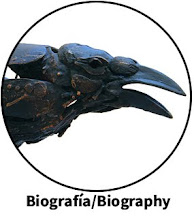Thursday, February 9, 2012
Course on Fusible Crucible
Balance, Recurvirostra avosetta
Model in wax, 100x47x29 cm aprox.
Every artistic process of Wildlife Art begins with direct experience in nature. I was lucky to see a mating between two avocets at the Navaseca Lagoon next to the Tablas de Daimiel National Park . I had already thought about making this kind of work and watching the scene was a great help so as to correct some little mistakes in my previous sketch.
Preliminary study of the work in wax
Wax, 60x30x23 cm. aprox.
These days I am using sheets of wax as construction means. This sketch is a round shape made to be developed in polyester resin and painted in oils.
Sketch of Balance, Recurvirostra avosetta
Graphite pencil in paper, 50x25 cm.
Morphological study of a wing of Recurvirostra avosetta
Graphite pencil on paper, 50x25 cm.
Sketch of a female Recurvirostra avosetta
Graphite pencil on paper, 25x50 cm.
I made some morphological studies of the species; as this is a dynamic process I had to make new notes during the modeling process of the piece.
After the modeling (which was a 3 week-process working five hours a day), the intensive week in which wax is transformed into bronze begins. This time I attended the lessons of Dr. Juan Carlos Albaladejo González, Professor in the Department of Painting and Sculpture of La Laguna University, in Tenerife. He showed us his innovative method in artistic casting: Lost-wax casting by using `fusible crucible´
Here are some pictures of our work during last week.
Preparing the casting tree.
Dr. Albaladejo explains how to join the crucible and the casting mould.
Preparing the support to separate the mould from the floor.
Removing wax.
Our improvised workshop at the yard of the Community Center "Casa de las Sirenas" in the Alameda de Hércules (in the historic center of Seville).
Finally I could make two moulds: the body and the wings of the male. I´ll try to cast the female in July.
First knocks on the mould after the casting.
Removing the ceramics shell.
The pieces have part of the ceramics shell. They are at an exhibition in the same place we were working in.
I still have to remove the ceramics shell and the casting tree, brush the piece, sweat the body and the wings, coating it and assembling it with my typical rectangles which symbolize the small room we leave for nature.
Finally, I´d like to thank Carmen and Itahisa for persuading Dr. Albaladejo to teach us. I am also grateful to José A. Aguilar and Enrique Caetano for the organization, we all know the upheaval of a casting in a mutipurpose classroom. Thanks to my friends Andrés and Lolita, you are part of my family.
To Cordero, Tannia, Bea, Marta and Luis G. Cruz (my teacher), Jorge, Gil, Manu, Lolo, Mónica and everybody else, thank you for being there.
Labels:
Sculptures






























